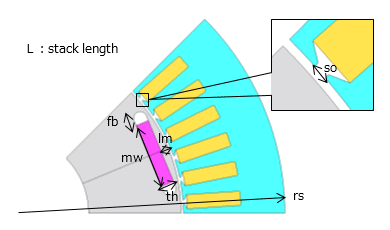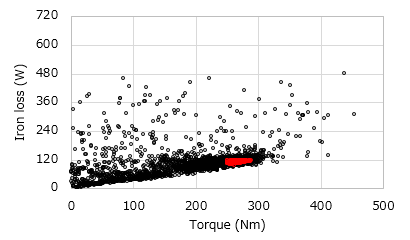Contents
Introduction
1. PM Motor multi-objective multi-constraint optimization issues
2. Optimization calculation speed-up by narrowing down the design space
3. Comparison between methods for narrowing down the design space
3.1 Narrowing down the design space with the equivalent circuit model
3.2 Narrowing down using the experimental design method
4. Narrowing-down methods and calculation cost
5. Summary
6. References
Introduction
Multi-objective multi-constraint optimization is required for the design of high-performance electrical appliances because of their need to satisfy a multitude of requirements. Optimization issues such as these perform searches within small and complex regions (design spaces that satisfy all constraints). Multipoint searches such as genetic algorithms (GA) are useful as search methods, but there exists the issue of calculation amounts increasing significantly in size. Pre-processing occurs in the form of narrowing down the design space as so to reduce these calculation amounts. However, depending on the way in which this narrowing down takes place, there exists the importance of factors such as experience, making personal judgements, or the risk of these narrowing-down processes not being carried out correctly.
This document shows a reduction in calculation costs by narrowing down the design space as an optimization calculation pre-process using PM motor optimization issues as an example. Furthermore, and in terms of narrowing-down methods, comparisons are performed between GA which uses an equivalent circuit model, an experimental design method, and GA using an FEA model. It is shown that despite the low calculation cost, the equivalent circuit model and experimental design method cannot perform narrowing-down processes correctly.
1. PM Motor multi-objective multi-constraint optimization issues
Optimization issues for appliances that require high performance, such as vehicle traction motors, require multi-objective functions and constraints. Because the operating regions for traction motors are evaluated with planes rather than single points, for example, objective functions such as torque are required for multiple operating points. There additionally tends to be an increase in the number of objective functions such as the trade-off between magnetic design and mechanical design. A three-fold increase or more in maximum rotation speed, for example, will lead to the necessity of handling issues such as the resulting loss reduction and cooling.

Motor geometry and variable dimensions

Optimization calculation results and feasible solutions (first stage only)
The vertical axis is iron loss at low speed, and the horizontal axis is torque at low speed. Black shows the individuals of all generations, and red shows feasible solutions. The number of feasible solutions is 334.
You need to sign in as a Regular JMAG Software User (paid user) or JMAG WEB MEMBER (free membership).
By registering as a JMAG WEB MEMBER, you can browse technical materials and other member-only contents for free.
If you are not registered, click the “Create an Account” button.
Create an Account Sign in



